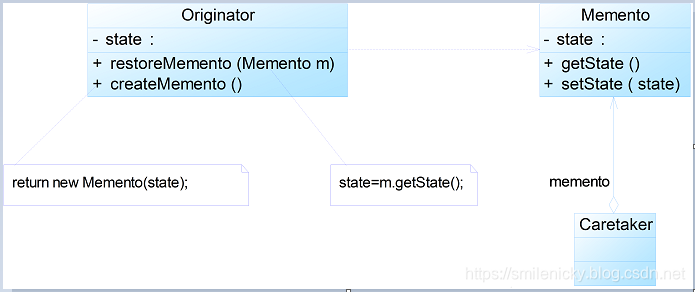版权声明:本文为博主原创文章,未经博主允许不得转载。 https://blog.csdn.net/u014427391/article/details/88598079
一、模式定义
备忘录模式(Memento Pattern):备忘录模式的定义是在不破坏封装的前提下,捕获一个对象的内部状态,并将该对象之外保存这个状态,这样可以在以后将对象恢复到原先保存的状态。所以备忘录模式就是一种对象行为型模式。
二、模式角色
备忘录模式包括下面角色
- Originator(原发器)
- Memento(备忘录)
- Caretaker(负责人)

备忘录模式包括原发器类,备忘录类和负责人类。原发器可以创建一个备忘录,备忘录类存储原发器类的内部状态,根据原发器来决定保存哪些内部状态,负责人类负责保存备忘录
三、模式分析
备忘录模式主要应用于备份或者回退操作,为了使软件使用更友好,通常都有回退功能,软件一般也要提供回退机制,而要实现回退,就必须事先备份好状态信息,所以有了备忘录模式就有实现系统回退到某一个特定的历史状态。
备忘录对象用于存储另外一个对象内部状态的快照对象,所以备忘录模式又可以称之为快照模式(Snapshot Pattern)或Token模式
典型代码:
原发器类:
public class Originator {
private String state;
public Originator(){}
// 创建一个备忘录对象
public Memento createMemento(){
return new Memento(this);
}
// 根据备忘录对象恢复原发器状态
public void restoreMemento(Memento m){
state = m.state;
}
public void setState(String state)
{
this.state=state;
}
public String getState()
{
return this.state;
}
}
备忘录类:
public class Memento {
private String state;
public Memento(Originator o){
state = o.state;
}
public void setState(String state)
{
this.state=state;
}
public String getState()
{
return this.state;
}
}
负责人类:
import java.util.ArrayList;
import java.util.List;
public class CareTaker {
private List<Memento> mementoList = new ArrayList<Memento>();
public void add(Memento state){
mementoList.add(state);
}
public Memento get(int index){
return mementoList.get(index);
}
}
四、模式例子
实例:用户信息操作撤销
某系统提供了用户信息操作模块,用户可以修改自己的各项信息。为了使操作过程更加人性化,现使用备忘录模式对系统进行改进,使得用户在进行了错误操作之后可以恢复到操作之前的状态。
本例子来自《设计模式》一书
原发器类,创建备忘录类
package dp.memento;
public class UserInfoDTO
{
private String account;
private String password;
private String telNo;
public String getAccount()
{
return account;
}
public void setAccount(String account)
{
this.account=account;
}
public String getPassword()
{
return password;
}
public void setPassword(String password)
{
this.password=password;
}
public String getTelNo()
{
return telNo;
}
public void setTelNo(String telNo)
{
this.telNo=telNo;
}
public Memento saveMemento()
{
return new Memento(account,password,telNo);
}
public void restoreMemento(Memento memento)
{
this.account=memento.getAccount();
this.password=memento.getPassword();
this.telNo=memento.getTelNo();
}
public void show()
{
System.out.println("Account:" + this.account);
System.out.println("Password:" + this.password);
System.out.println("TelNo:" + this.telNo);
}
}
备忘录类,保存原发器类状态:
package dp.memento;
class Memento
{
private String account;
private String password;
private String telNo;
public Memento(String account,String password,String telNo)
{
this.account=account;
this.password=password;
this.telNo=telNo;
}
public String getAccount()
{
return account;
}
public void setAccount(String account)
{
this.account=account;
}
public String getPassword()
{
return password;
}
public void setPassword(String password)
{
this.password=password;
}
public String getTelNo()
{
return telNo;
}
public void setTelNo(String telNo)
{
this.telNo=telNo;
}
}
负责人类,创建备忘录:
package dp.memento;
public class Caretaker
{
private Memento memento;
public Memento getMemento()
{
return memento;
}
public void setMemento(Memento memento)
{
this.memento=memento;
}
}
五、模式应用
- 软件里的存档操作
- Windows 里的 ctri + z。
- IE 中的后退操作
- 数据库的事务管理
…